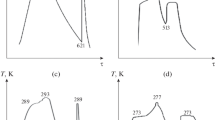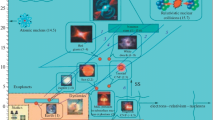Abstract
If matter is suddenly put under a high pressure, for example, a pressure of 100 Mb = 1014 dyn/cm2, it can undergo a transformation into molecular excited states, bound by inner electron shells, with keV potential wells for the electrons. If this happens, the electrons can under the emission of X-rays go into the groundstate of the molecule formed under the high pressure. At a pressure of the order ∼1014 dyn/cm2, these molecules store in their excited states an energy with an energy density of the order ∼1014 erg/cm3, about 1,000 times larger than for combustible chemicals under normal pressures. Furthermore, with the much larger optical path length of keV photons compared to the path length of eV photons, these superexplosives can reach at their surface an energy flux density (c = 3 × 1010 cm/s) of the order (c/3) × 1014 = 1024 erg/cm2s = 1017W/cm2, large enough for the ignition of thermonuclear reactions.




Similar content being viewed by others
References
R.E. Kidder, Physics of High Energy Density (Academic Press, 1971), p. 306
F. Winterberg, Physics of High Energy Density (Academic Press, 1971), p. 397
C. Maisonnier, Il Nuovo Cimento 426, 332 (1966)
F. Winterberg, J. Nucl. Energy Part C, 8, 541 (1966)
G. Guderley, Luftfahrtforschung, 19, 302 (1942)
B. Müller, J. Rafelski, W. Greiner, Phys. Lett. 47B(1), 5 (1973)
R.W. Pohl, Optik, vol. 208 (Springer, 1940)
M. Schwarzschild, Structure and Evolution of the Stars (Princeton University Press, 1958), p. 44
T.W.L. Sanford, T.J. Nash, R.C. Mock, R.B. Spielman, K.W. Struve, J.H. Hammer, J.S. De Groot, K.G. Whitney, J.P. Apruzese, Phys. Plasmas 69, 02188 (1997)
C. Deeney, M.R. Douglas, R.B. Spielman, T.J. Nash, D.L. Peterson, P. L’Eplattenier, G.A. Chandler, J.F. Seamen, K.W. Struve, Phys. Rev. Lett. 81, 4883–4886 (1998)
Y.K. Bae, Y.Y. Chu, L. Friedman, Phys. Rev. 54, R1742 (1995)
Acknowledgments
The idea presented in this paper, first considered in 1974, was stimulated by the paper of B. Müller, J. Rafelski, and W. Greiner, and I acknowledge the very useful conversation I had at that time with Dr. Rafelski in Frankfurt, Germany.
Author information
Authors and Affiliations
Corresponding author
Appendix: The Quantum Mechanical Eigenvalues of Two-atom Molecule Two-center Configurations
Appendix: The Quantum Mechanical Eigenvalues of Two-atom Molecule Two-center Configurations
This is the extension of the Heitler–London theory for the chemical bonding of two hydrogen atoms to heavier elements. It is fortunate that this problem has already been solved to predict the outcome of heavy atom collisions, and one can simply use the results obtained [6]. Because in the collision of the heaviest atoms, the effective two center electric charge can exceed the critical value Zcrit = 137, above which vacuum breakdown begins to set in, one has here to use the two center Dirac equation for an electron of mass M in the field of two electric charges located at –R and R:
Introducing prolate spheroidal coordinates ξ, η, φ, one has with the z-axis going from −R to R:
With m + 1/2 the angular momentum around the z-axis, the φ dependence in (A.1) can be separated setting
resulting in
where
Equation A.4 is separable in a ξ and η dependence setting
where L αi and P αi are the associated Laguerre and Legendre polynomials. In Eq. A.6, a is a scaling factor, not affecting the energy eigenvalue E. Furthermore, χ s are the unit spin vectors, ɛ s = 0 for s odd and ɛ s = 1 for s even. Inserting (A.6) into (A.4), one obtains the energy eigenvalues. As noticed by Muller et al. [6], the energy eigenvalues exhibit a “run way” toward distances of separation of the order 103 fm, which is an indication of the potential well in Fig. 3.
If the two atoms just touch each other without the application of an external pressure, one can approximately set for their distance of separation 1 Angström = 105 fm. Under the high pressure of 1014 dyn/cm2, their mutual distance of separation is reduced from 105 fm down to 5 × 104fm.
Rights and permissions
About this article
Cite this article
Winterberg, F. Conjectured Metastable Super-explosives Formed Under High Pressure for Thermonuclear Ignition. J Fusion Energ 27, 250–255 (2008). https://doi.org/10.1007/s10894-008-9143-4
Published:
Issue Date:
DOI: https://doi.org/10.1007/s10894-008-9143-4




